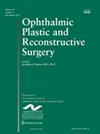肉毒杆菌毒素注射用于上面部年轻化和眼轮匝肌外侧症是否会对泪液分泌产生意外影响?
IF 1.2
4区 医学
Q3 OPHTHALMOLOGY
Ophthalmic Plastic and Reconstructive Surgery
Pub Date : 2024-09-10
DOI:10.1097/iop.0000000000002785
引用次数: 0
摘要
目的报告在寻求眼睑手术的患者中,注射 A 型肉毒毒素(BoNTA)对基础泪液分泌的影响(通过 Schirmer's 测试进行麻醉测量)。方法回顾性队列 2021 年 1 月至 2024 年 4 月期间由一名临床医生审查的要求进行眼睑美容手术的患者,通过 Schirmer's 测试进行麻醉评估。记录了人口统计学数据、眼周 BoNTA 治疗史、眼表疾病指数干眼症状频率以及对眼部润滑剂的需求。将无 BoNTA 治疗史的患者分为第一组,近期有眼周 BoNTA 治疗史的患者分为第二组。 比较各组之间 Schirmer's 测试麻醉(基础泪液分泌)测试结果小于 5 毫米("低")、5 至 9 毫米("边缘")和≥10 毫米("正常")的眼睛比例。 结果评估了 722 只眼睛(361 名患者),其中 670 只眼睛(335 名患者)符合纳入标准。平均年龄为 55.1 岁(17-93 岁),71.3% 为女性。第 1 组的施尔默数据为 "低 "的占 32.9%,"边缘 "的占 26.4%,"正常 "的占 40.7%。相比之下,第 2 组的结果明显较低(P ≤ 0.05),读数为 "低 "的占 48.3%,"边缘 "的占 26.7%,"正常 "的占 25.0%。结论注射过 BoNTA 的患者与从未注射过 BoNTA 的患者相比,基础泪液分泌量明显较低。BoNTA美容治疗可能会产生意想不到的效果,即基础泪液分泌减少,从而导致干眼症风险。本文章由计算机程序翻译,如有差异,请以英文原文为准。
Do Botulinum Toxin Injections for Upper Face Rejuvenation and Lateral Canthal Rhytids Have Unintended Effects on Tear Production?
PURPOSE
To report the influence of botulinum toxin A (BoNTA) injections on basal tear production, as measured by Schirmer's test with anesthesia in patients seeking eyelid surgery.
METHODS
A retrospective cohort of patients requesting esthetic eyelid surgery reviewed by a single clinician between January 2021 to April 2024, assessed with Schirmer's test with anesthesia. Demographic data, history of BoNTA treatment in the periocular region, ocular surface disease index dry eye symptom frequency, and requirement for ocular lubricants were recorded. Patients with no history of BoNTA were designated as group 1. Patients with a positive recent history of periocular BoNTA were designated as group 2. The proportions of eyes with Schirmer's test with anesthesia (basal tear production) test result <5 mm ("low"), 5 to 9 mm ("borderline"), and ≥10 mm ("normal") were compared between groups.
RESULTS
Seven hundred twenty-two eyes (361 patients) were assessed, of which 670 eyes (335 patients) met the inclusion criteria. Mean age was 55.1 (range, 17-93) years, with 71.3% female. Schirmer's data in group 1 were "low" at 32.9%, "borderline" at 26.4%, and "normal" at 40.7%. In contrast, group 2 had significantly lower results (P ≤ 0.05), with readings "low" at 48.3%, "borderline" at 26.7%, and "normal" at 25.0%. However, there were no significant differences between groups in ocular surface disease index symptom frequency scores or ocular lubricant requirements.
CONCLUSIONS
Patients who had received BoNTA injections had significantly lower basal tear production compared with patients who had never received BoNTA. Esthetic BoNTA treatment may be associated with an unintended effect of decreased basal tear production and subsequent risk of dry eye.
求助全文
通过发布文献求助,成功后即可免费获取论文全文。
去求助
来源期刊
CiteScore
2.50
自引率
10.00%
发文量
322
审稿时长
3-8 weeks
期刊介绍:
Ophthalmic Plastic and Reconstructive Surgery features original articles and reviews on topics such as ptosis, eyelid reconstruction, orbital diagnosis and surgery, lacrimal problems, and eyelid malposition. Update reports on diagnostic techniques, surgical equipment and instrumentation, and medical therapies are included, as well as detailed analyses of recent research findings and their clinical applications.

 求助内容:
求助内容: 应助结果提醒方式:
应助结果提醒方式:


